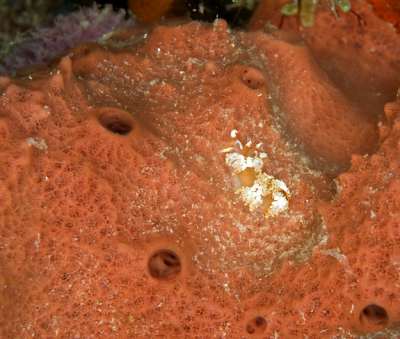Austraeolis catina and its food? sponge
September 20, 2005
From: Linda Ianniello

Dr. Bill,
I found three Austraeolis catina last night. They were all on the sponge shown in the enclosed shot, which I believe is their food sponge. I also included a close-up of one of the slugs.
Locality: The Gazebo, Boynton Beach, Florida, USA. Depth: 60 ft. 17 September 2005. Reef. Photographer: Linda Ianniello
Linda Ianniello
lindai1@bellsouth.net
Ianniello, L.M., 2005 (Sep 20) Austraeolis catina and its food? sponge. [Message in] Sea Slug Forum. Australian Museum, Sydney. Available from http://www.seaslugforum.net/find/14798
Dear Linda,
Thanks for these interesting photos - and for raising the possibility that this animal feeds on a sponge. Although all things are possible, I don't think any aeolid has been observed feeding on sponges. I agree that most of the other records we have of thios species show it on this very sponge suggesting a close association between the sponge and the aeolid. However I think this is probably the same sort of association species of Trapania have with particular sponges - they don't feed on the sponges, but they feed on an animal which lives in close association with the sponge.
I suspect A. catina may be feeding on a hydroid which lives in close association with this sponge. I have just added some illustrations to Fact Sheet of Cuthona kuiteri, because that remarkable species, as well as having cerata which mimic the hydroid polyp it feeds on, also live in close association with a sponge, but feed on an hydroid, Zyzzyzus spongicola, which is a solitary tubularian living partially buried in sponge colonies. It would be interesting if next time you saw this aeolid on the sponge, you had a close look for small hydroid polyps. I am sure that is not the easiest request, because the polyps are likely to be small, and are likely to retract if startled, either by unusual water movement or even by shadows passing over them.
When you see the aeolid on the sponge it is remarkably well camouflaged. The translucent orange breaks up the body shape leaving the white bits to look like bits of white coral sand.
Best wishes,
Bill Rudman
Related messages
-
Re: Austraeolis catina from St Kitts, Caribbean Se
From: Eric Kaye, March 26, 2010 -
Austraeolis catina from St Kitts, Caribbean Sea
From: Eric Kaye, March 24, 2010 -
Austraeolis catina and its sponge
From: Bill Rudman, April 16, 2007 -
Austraeolis catina from Bonaire, Caribbean Sea
From: Marianne Ligthart, April 16, 2007 -
Re: Bahama slugs
From: Marli Wakeling, February 15, 2001 -
Re: Bahama slugs
From: Anne DuPont, February 14, 2001 -
Re: The 'Long-Horn' aeolid from Belize
From: Sandra Millen, August 26, 1999 -
The 'Long-Horn' aeolid from Belize
From: Anne DuPont, August 25, 1999
